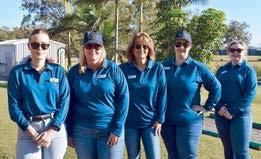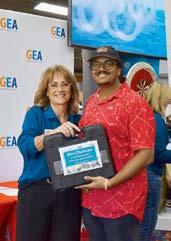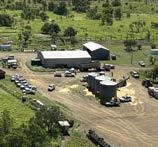August 2024 edition

Coal mine’s environmental honour pages 6-7
Examining green hydrogen page 9
Priorities for parties this state election page 10

August 2024 edition

Coal mine’s environmental honour pages 6-7
Examining green hydrogen page 9
Priorities for parties this state election page 10
Rockhampton Regional Council has launched the Maximising Local Jobs and Content in Major Projects program.
The program aims to help businesses secure work on the region’s $12 billion project pipeline.
Delivered by council’s lead economic development agency, Advance Rockhampton, the program offers free one-on-one mentorship and support for 15 local businesses to increase their understanding of the tender and procurement process, and ability to successfully secure contracts for major projects.
The Maximising Local Jobs and Content in Major Projects program will also include three targeted workshops which will be open to the broader business community.
Rockhampton Region Mayor Tony Williams said upskilling local businesses was the key to increasing jobs and economic growth.
“The tender process can be complicated and intimidating at times, particularly for major projects. Through these workshops, businesses will be equipped with the knowledge and tools they will need to get a foot in the
door,” Cr Williams said.
“This is a unique opportunity for 15 of our most promising businesses to take advantage of future infrastructure, resources and energy projects by connecting them with an experienced consultant who will provide them with the knowledge, and documentation to apply for major contracts.
“Our broader business community can also take advantage of three free workshops where they will be provided with document templates and workbooks to upskill their tender and pro-
curement knowledge.”
Cr Williams said the program seeks to stimulate economic growth, create job opportunities and foster a more sustainable future for the Beef Capital and beyond.
“This program presents enormous value for businesses taking part, regardless of their size or specific industry. Our business community needs to unite and seize the opportunities which lay ahead, supporting each other by sharing knowledge and considering joint ventures and collaborations to secure key contracts,” he said.
One Nation candidates are reminding residents of the importance of Queensland mining ahead of the state election.
The Queensland Resources Council reported a $2.9 billion boon to the region in the 2022/23 financial year, which One Nation candidate for Keppel James Ashby said underpinned Central Queensland’s prosperity.
“There are more than 3200 people directly employed in the resources sector who predominately drive in and out to their mining jobs, bringing in over $491 million in wages to both Keppel and Rockhampton,” Mr Ashby said.
“Many of those jobs have been put at risk by this Labor government who have implemented the world’s highest coal royalty regime and increased the hurdles that have led to long delays in getting new projects off the ground.
“Many investors are choosing to start mining projects in other countries as a result of the red tape this government have implemented and that puts jobs at risk when the life of our current mines expire over time.”
One Nation candidate for Rockhampton David Bond echoed Mr Ashby’s calls for the mining sector to be supported, not denigrated, at a time when regional services languish.
“Mine is one of the 725 businesses who share in the benefits of mining to our area, and so do my kids who are among the participants in the 84 sports and charities that are again supported by mining,” Mr Bond said.
“Commodities are Australia’s greatest export, and they create endless opportunities for so many other sectors. Many of our miners have greater disposable incomes which is in turn spent in so many of our hospitality, service and retail businesses here in Rockhampton and Keppel.
“Our region has so much to lose if we allow Labor to continue over-exploiting royalty charges – instead we need to strike a balanced royalty regime that puts Queensland back into a competitive state with New South Wales.”

Mr Ashby attended this year’s Future Queensland Resources event in Brisbane in support of the sector and is encouraging the
Telephone: 07 4863 5050
Address: 5-9 Hempenstall Street, Kawana, QLD 4701
EDITORIAL
Breanna Lloyd Journalist
E: breanna.lloyd@CQToday.com.au
Matthew Pearce Journalist
E: matthew.pearce@CQToday.com.au
ADVERTISING
Cheryl Altouvas Advertising Sales
E: cheryl.altouvas@GladstoneToday.com.au
Lacy McDonald-Hearn
Advertising Sales Executive
E: lacy.mcdonaldhearn@CQToday.com.au
Lou De Jager
Advertising Sales Executive
E: lou.dejager@CQToday.com.au
region’s students to look at a career in mining upon completion of high school.
“I’d much prefer to see these high paying
jobs go to local kids than see our federal government bring in foreign workers to fill the mining jobs of the future,” he said.
Borrowers should not rule out the prospect of another interest hike as the head of Australia’s central bank warns rates may need to go higher if inflationary pressures persist.
Doubling down on the assertive tone adopted after this month’s board meeting, Reserve Bank of Australia governor Michele Bullock said inflation was “still too high” and services prices, such as rents and insurance, were proving “very sticky”.
Interest rates were kept on hold at 4.35 per cent at the RBA’s August meeting, where they have been since November 2023. The governor also pushed back on expectations of a nearterm cut. Ramming home the message in a lecture at the Rotary Club of Armidale, Ms Bullock said the board remained “vigilant” to upside inflation risks and “will not hesitate to raise rates if it needs to”.
Refreshed economic forecasts from the bank have underlying inflation staying higher

for longer, in part due to a stronger-than-expected outlook for domestic demand influenced by recovering household consumption and stronger public spending.
The assessment has put federal and state governments under pressure to prove their policies are helping combat price pressures, allowing the RBA to cut interest rates sooner rather than later.
Ms Bullock said monetary and fiscal policy were needed to help tame inflation, yet the government had a raft of other jobs as well, such as providing services and infrastructure to citizens.
“So, they need to do that at the same time as they need to focus on keeping inflation down,” she said.
“My personal view is that they’re doing what they can do in that area, and I’m doing what I can do in that area.”
Australia had not jacked up interest rates as high as other countries, she added, which meant policy was a “bit less restrictive” than in other parts of the world “so we need to be a little bit careful”.
Yet were she faced with a “multitude of evidence” the economy was turning down much more quickly than thought, including rising unemployment and falling inflation, the board would lower interest rates.
By Gregor Mactaggart
The State Government has announced the Central Queensland Regional Transformation Strategy.
The strategy, developed following extensive community, local government and industry consultation, aims to assist the region in seizing opportunities presented by decarbonisation.
It identifies key economic strengths and industry priorities, based on CQ’s geography, resources and workforce skills.
The State Government has committed $17.7 million from the $200m Regional Economics Future Fund for 14 projects.
This includes a $5.4 million contribution towards a $9 million industrial precinct proposed by Banana Shire Council to accommodate low
carbon emission industries in Biloela.
A total of $3 million has been allocated to improve accessibility to the Parkhurst Industrial Area, enabling new industrial investment.
Rockhampton Regional Council will receive $1 million to support the development of a defence industry storage and distribution precinct.
A total of $850,000 has been committed for Rockhampton Regional Council to develop a business case for the South Yaamba Irrigation Development, aimed at enabling horticultural development and food manufacturing opportunities.
Regional Development Minister Glenn Butcher said the fund would be a winner for CQ.
“We’re not only decarbonising our economy, but we’re delivering more jobs for Central
Queenslanders,” he said.
“We’re planning for the future – unlike the LNP who are planning to privatise Queensland energy assets.”
Keppel MP Brittany Lauga said the strategy is a great example of what the region needs in the coming years.
“It’s no secret that the world is turning to a renewable, clean energy future,” she said.
“Not only does this plan invest in Central Queensland, but it does so with a focus on emerging sustainable technologies. It will capitalise on funding projects that will enhance our status as an emerging clean energy powerhouse.”
Rockhampton MP Barry O’Rourke said the strategy capitalises on CQ’s expertise and resources.
“Our Regional Transformation Strategy
coupled with the Regional Economic Futures Fund will mean the Rockhampton region’s skills, knowledge and ideas can drive the future of this state,” he said.
“It’s going to be exciting to see the new industries and businesses that grow as a result.”
Rockhampton Region Mayor Tony Williams said the region is on a path to securing new jobs, industries and economic growth.
“We know there are changes occurring at a national and global level that will shape our local economies in the future,” he said.
“The Regional Transformation Strategy sets out a blueprint to diversify and evolve our regions to take advantage of those changes and ensure that all of Queensland has the plan and tools to succeed.”
Rockhampton will be the hub of Central Queensland dialogue next month when it hosts the 2024 Major Projects and Industry Forum.
Presented by Capricorn Enterprise, the forum will gather influential industry leaders, experts, and stakeholders to discuss the region’s key developments and future opportunities at the Frenchville Sports Club on Thursday, 12 September.
Recognised as the region’s premier industry event, the forum features presentations from high-profile organisations, including the Energy Users Association of Australia, Gladstone Area Water Board, Construction Skills Queensland, CQUniversity, Stanwell, Central Queensland Power, and Ergon Energy/Energex.
These industry leaders will provide valuable insights into current projects, emerging industry trends, and new economic opportunities within the region.
Capricorn Enterprise chief executive officer Mary Carroll said the 2024 forum would serve as a critical platform for showcasing the region’s strengths and future potential.
“Central Queensland has always been a driving force in the state’s economy,” Ms Carroll said.
“With our strategic location, abundant natural resources, and robust industries, we are well-positioned to capitalise on the opportunities that lie ahead.”
Capricorn Enterprise industry engagement manager Frank Edwards said the region boasts significant strengths in the energy, construction, education and health service sectors.
“As an economic hub for Central Queensland, the region plays a pivotal role in the state’s growth, with ongoing transport,

energy, and water projects expected to sustain elevated levels of development through to 2025,” Mr Edwards said.
This sell-out event provides a unique opportunity for networking, collaboration, and gaining valuable insights into the future of
Central Queensland’s industries.
Early bird tickets are now on sale from $99 (members) - $109 (non-members).
For more information and to register, please visit https://capricornenterprise.com. au/mpif-2024/




By Karen Simmons
Assistant Minister for Trade and a Future Made in Australia, Senator Tim Ayres visited Gladstone on Friday, 9 August to discuss bringing more local manufacturing and jobs to the Gladstone Region.
Gladstone Engineering Alliance hosted the roundtable for local manufacturers and businesses to meet with Senator Ayres; State Regional Development and Manufacturing Minister Glenn Butcher and Gladstone Regional Council Mayor Matt Burnett to discuss how A Future Made in Australia can deliver future prosperity and good jobs for the Harbour City.
The Future Made in Australia agenda has committed to returning manufacturing to regional Queensland – clean, new, modern manufacturing which will deliver good new jobs to the area.
Senator Ayres said A Future Made in Australia means manufacturing returns to regional communities.
“The first thing to say is a Future Made in Australia is the biggest pro-manufacturing package in our history,” he said.
“It’s the Albanese Government making sure that we’re doing the things and providing the incentives to deliver big investments in big manufacturing around Australia.
“New investment in manufacturing will create new jobs and career opportunities, including apprenticeships and careers in engineering, science, and technology for boys and girls in school today.



“These are good jobs that young families can build a quality life around and that communities can count on.
“Good jobs with purpose that contribute to a stronger and more resilient Australia.”
Senator Ayres said he had some good dis-

cussions during his visit with the Gladstone Industry Leadership Group and Gladstone Engineering Alliance.
“This community, I have to tell you, it’s so exciting to be here - the capability, the optimism, the hard work that’s going into building
manufacturing in this great resources and engineering centre of Queensland,” he said.
“Because of its history as a resources powerhouse, it means it’s got all the capabilities that are needed for the new economy.
“97 per cent of our trading partners are shifting to net zero, that means Australia’s got to adjust.
“This is a task of rebuilding Australian manufacturing - It’s going to shape our economy in the national interest for generations ahead.”
Mr Butcher said Queensland has the capabilities, the resources and the people to propel renewable energy production in Australia and the world.
“Gladstone has always been the state’s industrial powerhouse and the epicentre for innovation so it is fitting we’re planning Queensland’s energy and manufacturing future here in this region,” Mr Butcher said.
“The Miles Labor Government is working with the Australian Government to secure more opportunities and good jobs for Queenslanders because we know the pivotal role our great state plays in a Future Made in Australia.”
Cr Burnett said it was fantastic to see all eyes are on Gladstone when it comes to delivering new jobs in new industries.
“The sun is quickly rising on renewable energy projects in our region and we are well positioned to capitalise on the emerging industries and opportunities that will come from the plan,” he said.



Embracing the richness of cultural heritage alongside the vitality of the local industry, a two-day educational experience delivered by the Queensland Minerals and Energy Academy is set to empower Indigenous students from Blackwater to pursue rewarding careers in mining.
Thanks to a collaborative initiative between Coronado Global Resources and the QMEA, the education arm of the Queensland Resources Council, 23 students from Blackwater State High School will gain valuable insights into the leading cultural heritage practices of the local resources and energy sector.
QRC Skills, Education and Diversity director Katrina-Lee Jones said ‘Yarbun Rhunga’, now in its third year, is a unique experience offered exclusively to Indigenous students in Years 9 to 11 from Blackwater State High School.
“The experience kicked off on Wednesday with an exclusive behind-the-scenes tour of Coronado’s Curragh Mine, where students will get the rare opportunity to discover firsthand the many exciting local career opportunities on offer,” Ms Jones said.
“Thursday was dedicated to an Indigenous yarning circle hosted by Milton Lawton, a proud Ghungalu man who will guide students as they explore and celebrate their cultural heritage, helping them cultivate a deep appreciation for their ancestral roots.”

“This two-day program provides Indigenous students with a comprehensive experience that merges environmental awareness and career pathways with cultural importance,“ Ms Pollard said.
“We’re proud to help these students draw stronger connections between cultural heri-
Coronado Global Resources chief people and sustainability officer Emma Pollard said students will also participate in a hands-on cultural heritage assessment activity on school grounds, helping them grasp the significance of preserving and integrating their cultural heritage within the local resources sector.
tage values and the resources sector.”
Blackwater State High School principal Rebecca Vitale said this experience is a valuable opportunity for students to learn more about the lands of the traditional Ghungalu custodians and local employment pathways.
“For the participating Indigenous students, this experience not only showcases how the resources sector builds relationships with Tra-
ditional Owners, but it also provides helpful career guidance that would allow them to stay connected to home and country,” Mrs Vitale said.
“Our school is extremely proud to be hosting this collaborative initiative again this year, empowering our students to carry their heritage forward in shaping a sustainable and prosperous future for the mining industry.”
Perhaps the Federal Climate Change and Energy Minister Chris Bowen should apply for a PO Box after yet another visit to Gladstone last month.
Mr Bowen attended an official opening at Orica’s Yarwun facility, in honour of new abatement technology that will help the global mining and infrastructure solutions provider and large Australian manufacturer achieve another decarbonisation milestone.
By deploying tertiary abatement technology at its Yarwun manufacturing facility in Gladstone, Orica expects to eliminate an estimated 200,000 tonnes of carbon dioxide equivalent (CO2-e) annually once the project is complete.
To celebrate these decarbonisation milestones, Mr Bowen and Orica managing director/chief executive officer Sanjeev Gandhi joined other officials at the ceremony.
The installation of two tertiary abatement reactors at the facility will eliminate the equivalent of approximately 50 per cent of the facility’s total greenhouse gas emissions - equivalent to taking 120,000 cars off the road.
The installation of the first reactor at Yarwun was achieved safely, on time and on budget earlier this year, with the second reactor in the final stages of commissioning, to be operational by the end of September.
It follows the successful implementation of similar tertiary emissions abatement technology at Orica’s Kooragang Island facility in New South Wales, which is forecast to reduce Australia’s chemical industry emissions by 11 per cent.
Speaking at the ceremony, Mr Gandhi said the milestone highlights Orica’s commitment to sustainability and to their long-term support of the Gladstone region.
“The federal parliament’s passage of safeguard reforms last year provided Orica with the investment certainty we needed to proceed with the extension of our decarbonisation strategy,” Mr Gandhi said.
“This outcome demonstrates how the right policy settings can enable key corporate commitments and result in significant emissions reductions, even across hard-to-abate sectors.”
Orica’s Yarwun facility supplies essential products to mining, agriculture and infrastructure customers throughout Australia and around the world.
This tertiary abatement will provide customers with lower carbon intensive products and enable the reduction of their Scope 3 emissions while supporting the overall decarbonisation goals of regional communities and economies.
Orica is also a strategic partner and shareholder in the neighbouring Alpha HPA manufacturing operations, an Australian-based company that produces ultra-high purity aluminium materials, serving end markets such as lithium-ion batteries, LED lighting, and smartphone manufacturing.
The partnership further reinforces Orica’s desire to grow its exposure in future-facing industries, including eMobility.
It also leverages Orica’s global manufacturing asset base, simultaneously creating value and reducing waste through a circular supply and offtake agreement with Alpha HPA.


By Di Stanley
In a boost for the coal mining industry’s often-criticised environmental credentials, the Bowen Basin’s newest coal producer has been lauded for its biodiversity management and scientific research to protect endangered onsite species.
Pembroke Resources chief executive officer Barry Tudor is justifiably proud of the Olive Downs Complex taking out the Hastings Deering Environment Award at the recent Queensland Mining Awards for its commitment – above and beyond the requirements to meet approvals – and demonstration of real excellence in setting new industry standards for environmental and fauna protection.
It’s as much a nod to Mr Tudor’s coexistence vision for the more than 40,000 hectare site started from greenfield a decade ago as it is to the future of newcomers like Annie, the koala tagged on 16 May this year, as well as John, Jackson, Pippa and the rover Garth, all able to be monitored from an app on his phone.
“We will measure ourselves against any conservation or wildlife organisation for what we do - don’t even mention mining,” Mr Tudor said.
“We’re as good as anything anybody is doing because we’re doing it from a scientific base, not because it’s associated with a mine.
“The research we’re doing on the koala and greater glider, hopefully we will do that for the benefit of these species Australia-wide.
“That’s our goal, better understanding of what’s driving those species, what threatens the species, why they thrive and we will feed that back to the scientific community nationwide and hopefully secure the species.
“We’re also the first ones to be allowed to research the greater gliders and tag them and we’ve found the biggest threat to greater gliders are feral cats.
“It’s just diabolical what these feral cats will do to these beautiful gliders.”
When the Olive Downs complex was first conditioned under the federal Environmental Protection and Biodiversity Conservation Act to protect its known koala habitat, the directive was for $1 million to be spent over 10 years.
“As I like to say, we spent a million probably in the first three months,” he said.
“I really mean it, it’s got to pass the pub test.”
Already a Koala and Greater Glider Clinic, staffed by veterinarians and wildlife ecologists has been established on the more than 40,000 hectare site of which 20,000ha is designated as a conservation area.
As well as the constant monitoring of the koala population, 700 nest boxes have been erected in the conservation zone for the greater gliders, Australia’s largest gliding mammal, with cameras and infrared drone technology to capture valuable research data.
“We’re very proud of the work we’re doing with the greater gliders, they’re not that wellknown and they’re not researched enough,” Mr Tudor said.

“There’s two sets of three scientific papers that are team are writing and we hope they will really aid the scientific understanding of the two species.
“It’s amazing to me to go onto site and see teams of spotter catchers, they’re ecologists that go on site and before any tree is disturbed and this is the protocol - they’ve already walked around, flown the infrared drone over, gone up on a cherry picker to check every nook and cranny and if they find a critter, they relocate it and close the nook and go back the next day to make sure they haven’t come back.
“These ecologists say to me they’ve never been on any development anywhere that is like this and these are not people who have got any learning towards mining, they effectively environmentalists.
“So, it’s an incredibly satisfying endorsement when they say that sort of thing to me, it’s also very satisfying when you’ve got people coming on and they might be a truck driver in the mine but they say we’re proud to be working for a mine that has this commitment

to the environment.
“... you also can’t have young people coming to work on your mine site who really do care for the environment unless you’re doing something that’s tangible and real.”
“It’s not rocket science is it? We’re just trying to look after the environment.”
The billion-dollar Olive Downs Complex, 40km southeast of Moranbah, was officially opened on Friday, 19 April after shipping its first coal to international customers in January 2024.
Creating 700 jobs in construction and 600 new jobs in its first phase of operation, its steelmaking metallurgical coal resources are estimated at 79 years.
The mine will contribute an estimated $10 billion in coal royalties over its life span.
“Steelmaking coal is just as important as the Pilbara and iron ore as the engine room of the world,” Mr Tudor said.
“Everybody needs steel and the Bowen Basin is the best basin in the world.

“We’re the newest entrant to that basin and I think we might be the last because I don’t see how anyone can do a greenfield major mine like us in the future, it almost killed me, but we’ve got fantastic customers and we feel we’re providing the best steelmaking coal in the world to those economies like south-east Asia, India and Indonesia that need this economic development to increase their standard of living and we’re proud to be part of it.”
Mr Tudor said the Olive Downs Complex, envisioned as an integrated campus with its mine, koala and greater glider clinic, conservation areas, pastoral activities, planned solar farm and green energy project, also hoped to build an eco-village.
“It’s a mining camp but also for the public as well,” he said.
“What we’re trying to do is illustrate to people that modern mining, it all coexists.
“It doesn’t all equal net zero and that’s not what we’re trying to do, but it is integrated and it is the future of mining.”
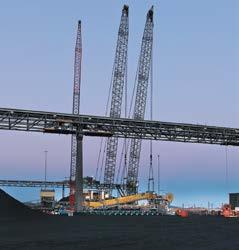

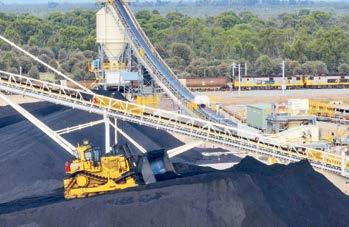




The 2024 Gladstone Engineering Alliance (GEA) Major Industry, Energy and Manufacturing Conference will be held on 2-3 October at the Gladstone Entertainment and Convention Centre.
Local company Aestec Services is the principal partner for this premier industry event taking place over two days in the industrial powerhouse of Queensland.
Conference delegates will be provided with the opportunity to gain insight and hear from influential guest speakers about where industry, energy and manufacturing is progressing, and the available opportunities held within the Central Queensland region over the course of the renewables transition.
Aestec Services managing director and founder Doug Deakin said that this conference serves as an important platform for industry
advancement and provides an invaluable opportunity to gain insight into CQ’s industrial and energy future.
“Connecting leaders and professionals from diverse sectors, this prestigious event ignites meaningful discussions on emerging trends and opportunities in the industry,” Mr Deakin said.
“Aestec Services is honoured to continue our commitment as the principal partner of the GEA Major Industry, Energy and Manufacturing Conference for the seventh year.
“Through our continued partnership, we are proud to support the conference in its mission to drive innovation, build connections, and shape the future of the industry.”
Day one focuses on current and future major industry projects, while day two will focus on the energy and manufacturing opportuni-
ties available in hydrogen, renewables and the energy sector.
GEA general manager Alison Murdoch stated that this prominent event will highlight the transformative forces shaping the industry, energy, and manufacturing sectors.
“It’s an exciting time, with renewable energy and other innovations taking centre stage,” she said.
“This year’s Major Industry, Energy, and Manufacturing Conference will emphasise the importance of preparing delegates for emerging opportunities in the supply chain. This event will be a valuable platform, providing delegates with the knowledge and insights necessary to navigate the evolving landscape.
“This year’s conference presents a unique opportunity for both new and established industries to come
together and explore the latest advancements. The region’s future is promising, and the conference will offer crucial insights into the direction it’s headed and how we can collectively prepare for success.”
The GEA Industry Awards and Gala Dinner, presented by Aestec Services, will take place on the first evening of the conference at the Gladstone Entertainment & Convention Centre.
Nominations for the awards are currently open and close on 30 August 2024.
The Industry Award categories are: The Safety Excellence Award, The Forty Calis Memorial Award, The Innovator Award, The Wayne Peachey Memorial Award, The GEA Industry Hall of Fame Award and The Beale Culture Award.
RACQ has joined forces with leading Queensland organisations to fight for a better Bruce Highway after new data revealed it has an average Fatal and Serious Injury (FSI) crash rate three to five times higher than major national highways in New South Wales and Victoria.
Ahead of October’s State Election, RACQ, Local Government Association of Queensland (LGAQ), Queensland Farmers Federation (QFF), Royal Australasian College of Surgeons, Queensland (RACS Qld), Queensland Trucking Association (QTA), and Queensland Tourism Industry Council (QTIC) are urging political parties to commit to a 10-year funding plan with the Federal Government to urgently eliminate all twostar sections of the Bruce Highway.
RACQ’s expert analysis of AusRAP crash data between 2018-2022 shows upgrades, including the installation of dual carriageways on the Hume and Pacific Highways have almost eliminated the head-on crash risk – the crash type in over half (81) of fatalities on the Bruce Highway.
By contrast, 1,398 kilometres of the Bruce Highway (from Gympie to Cairns) remains single-lane and undivided, leading to an average ‘per kilometre travelled’ FSI crash rate three times higher than rural sections of the Pacific Highway and five times higher than rural sections of the Hume Highway.
RACQ managing director and chief executive officer David Carter said the shocking statistics highlight the urgent need to Fix the Bruce.
“The Bruce Highway is the backbone of this state, it’s supposed to be a national highway but when you compare it to the Pacific or Hume, it’s substandard,” Mr Carter said.
“Those interstate highways have rightfully been upgraded to three, four and five stars out of five for infrastructure safety, yet around half of the Bruce is still a poor two-star rating. In 2024, there is no way Queensland should have any two-star sections on the Bruce Highway.”
While welcoming the State Government’s extra $50 million a year in the Budget, the groups warned it had been undermined by the Federal Government’s changed funding split from 80-20 with the State Government to 50-50.
They are seeking commitments that the State Government will take an industry and government delegation to Canberra in November prior to next year’s Federal Budget to secure fair funding for the Bruce and other road funding and a return to the 80-20 federal-state government funding split.
The road safety alliance is also calling for parties to make state election commitments to further fund the roads that Queenslanders deserve.
LGAQ chief executive officer Alison Smith said safe, reliable transport was critical for communities and councils and Queensland mayors and the LGAQ had joined Premier Steven Miles in a two-level delegation to Can-

berra to reverse the 50-50.
“As the level of government closest to their communities, councils see the huge emotional toll that crash deaths and injuries create, even before you come to the economic cost,” Ms Smith said.
“Ensuring more funding flows to improve road safety across our decentralised state is critical to Queensland councils because it is critical to improving the liveability of their local communities.
“Improving road safety and upgrading regional roads like the Bruce Highway is an important component of councils’ calls for better local infrastructure this State Election but also from the Federal Government.
“The Federal Government needs to restore the 80-20 funding split for Queensland – it is only fair.”
Queensland Farmers Federation chief executive officer Jo Sheppard said the Bruce Highway is an important corridor for the state’s agriculture sector and regional communities.
“The Bruce Highway is a highway of state significance providing an important conduit for many agriculture industries, while also
supporting economic development throughout the state,” Ms Sheppard said.
“Maintaining and enhancing transport and freight infrastructure is not only vital to support agricultural supply chains, which in turn ensures we as consumers have access to affordable Australian produce, it also ensures the safety of regional Queenslanders reliant on these roads.
“As a state we need vibrant thriving regional communities that support critical sectors like agriculture.”
The Royal Australasian College of Surgeons’ Queensland Trauma Committee chair, Professor Martin Wullschleger said the organisation supported upgrades to the Bruce.
“The Queensland Trauma Committee absolutely supports this as we see far too many crash victims in our emergency departments,” Prof Wullschleger said.
“An upgrade would not only ease the load on doctors and health services but most importantly reduce the burden of crashes with injuries and fatalities.”
Queensland Trucking Association chief executive officer Gary Mahon said the importance of securing the future of freight supply
chains in Queensland is without question.
“The road freight industry is heavily reliant on the Bruce Highway as a freight route to deliver into regional communities, get fresh produce to market and resources to ports,” he said.
“Bold investment decisions are needed to make this key freight route safer for our truck drivers who are providing an essential service to the state.
“Floodway treatments, improvements in the economic carry of bridges and rest areas every 200km must be a priority for the next Queensland Government.”
Queensland Tourism Industry Council chief executive officer Brett Fraser said the success of the state’s tourism industry depends on connectivity.
“Queensland tourism operators and key destinations are all too often cut off from the rest of the state and would-be visitors by flooding events impacting major sections of the Bruce Highway,” Mr Fraser said.
“From the city to the bush, it is critical that all of our exceptional locations, experiences and sights be easily accessible by travellers.”
Is green hydrogen really going to be the industrial-clean-energysaviour it is being headlined to be? In this edition we catch up with some prominent voices to help bring clarity to where we are on the timeline.
By Karen Simmons
Hydrogen has long been touted as a clean future fuel and a potential solution to energy challenges, especially for industries like those around the Gladstone and Rockhampton regions.
Almost all the world’s hydrogen currently comes from fossil fuels and its production is responsible for around 830 million tonnes of carbon dioxide a year.
Emissions-free ‘green’ hydrogen, made by splitting water, has been so expensive to make that it is largely commercially unviable and accounts for about one per cent of total hydrogen production globally.
But a new method from RMIT University researchers in Melbourne splits the seawater directly into hydrogen and oxygen - skipping the need for desalination and therefore, its associated cost, energy consumption and carbon emissions.
Lead researcher Dr Nasir Mahmood, a vicechancellor’s senior research fellow at RMIT, said green hydrogen production processes were both costly and relied on fresh or desalinated water.
“To be truly sustainable, the hydrogen we use must be 100 per cent carbon-free across the entire production life cycle and must not cut into the world’s precious freshwater reserves,” Dr Mahmood said.
“Our method to produce hydrogen straight from seawater is simple, scaleable and far more cost-effective than any green hydrogen approach currently in the market.
“Our process not only omits carbon dioxide, but also has no chlorine production.”
RMIT University has filed a provisional patent application for the new method, detailed in a lab-scale study published in Wiley journal, Small, titled: Splitting the difference: a catalyst for seawater.
The new approach devised by a team in the multidisciplinary Materials for Clean Energy

and Environment (MC2E) research group at RMIT uses a special type of catalyst developed to work specifically with seawater.
“These new catalysts take very little energy to run and could be used at room temperature,” Dr Mahmood said.
“While other experimental catalysts have been developed for seawater splitting, they are complex and hard to scale.
“Our approach focused on changing the internal chemistry of the catalysts through a simple method, which makes them relatively easy to produce at large-scale so they can be readily synthesised at industrial scales.”
Dr Mahmood said the technology had promise to significantly bring down the cost of electrolysers - enough to meet the Federal Government’s goal for green hydrogen production of $2/kilogram, to make it competitive with fossil fuel-sourced hydrogen.
Stanwell Corporation and CQUniversity have appointed a Professorial Research chair, globally-renowned clean energy expert, Professor Jonathan Love, who also believes saltwater will have a part to play in a green-energy future.
“I think seawater is going to be one of the major sustainable sources of water that does get utilised into the supply chain for hydrogen,” Prof Love said.
“Researchers are looking at it from different ways; one way is to change the materials and catalyst inside the electrolyser so it can actually work directly on seawater. But the current commercial electrolysers can’t do that - they degrade very quickly and produce a lot of chlorine.
“There are a number of materials in an electrolyser that can rust.
“People are researching new materials, and it will take quite a while - it will take a decade or more to come through.
“But another way is indirect seawater electrolysis, where they can use the waste heat from the electrolyser to treat the seawater into pure water and put that back into the electrolyser.
“Now, that’s something reasonably new, but it could be implemented faster and a lot sooner.”
Prof Love said another way to get green hydrogen from seawater would be to build a seawater treatment plant, but it needs another purification process.
“Some already exist in Queensland and I think that’s the way a lot of large production plants will go, initially,” he said.
“I think any hydrogen production plant along the coastline, will be using seawater.”
As part of his new role as Stanwell chair in Hydrogen, Prof Love will provide academic,

research and strategic leadership to initiate, develop and steer a team of researchers to deliver knowledge and innovation to support the development of a thriving hydrogen and renewable energy industry, with a specific focus on the Gladstone region and the Central Queensland Hydrogen Project (CQ-H2).
LNP Senator for Queensland, Matt Canavan said there is more chance that the Broncos will win the grand final this year than we will be exporting large quantities of hydrogen within a decade.
“There is more hype than hope around hydrogen right now,” Senator Canavan told Industry Today.
“Even Twiggy Forrest has dumped his hydrogen targets. I am not against continuing to research the possibility of a hydrogen industry.
“But it is economic insanity for the Labor party to shut down coal jobs on the remote chance that hydrogen might work out.
“In any case, I have never understood why we need to shut down one industry to open up another. By all means let’s try to open up a hydrogen industry over time but there is no need to do so at the expense of the coal industry.
“There is enormous and growing demand for Australia’s high-quality coal. Let’s grow the coal industry too.”
A $2 million Hydrogen Information Centre to be located at Gladstone’s CQUniversity Marina campus, will connect the community with industry stakeholders on the potential emerging green energy industry.
Community members will have the chance to learn more about the state’s projects including the more than 20 projects that are under development throughout Central Queensland.
CQUniversity’s Centre for Hydrogen and Renewable Energy director Paul Hodgson said the Hydrogen Community Information Centre is being funded by the Queensland and Federal governments through the Hydrogen Hub initiative and will be operated in collaboration with CQUniversity.
“The focus will be on building community awareness of the safe and sustainable production of hydrogen and its uses both domestically and offshore,” Mr Hodgson said.
“Though the Information Centre we will also help to showcase the exciting potential of hydrogen and renewable energy when it comes to Gladstone’s ongoing regional and economic development, and the growth opportunities in education, training and job creation.
“CQUniversity looks forward to working with industry, government and community stakeholders to help improve understanding of hydrogen production and usage and to re-

alise the potential benefits for Gladstone and the wider Central Queensland region.”
Dr Cal Devney will play a leading role in the new Hydrogen Information Centre as the project manager for the Hydrogen Community Hub.
“We are really excited to be working on this project with consortium partners,” Dr Devney said.
“We are also engaging with schools and
supporting teachers for professional development with the aim to support students from Prep to Year 12.”
The initiative is funded by matched funding from the Queensland and Australian Governments as part of the Stanwell-led Central Queensland Hydrogen Hub.
Stanwell and CQU also announced the deepening of their partnership, with Stanwell funding the establishment of a Professorial

Chair of Hydrogen at CQUniversity. Professor Jonathan Love has been appointed in that role.
He will focus on applied research that supports Stanwell’s strategic vision of advancing the hydrogen industry in Queensland and through the CQ-H2 Project.
StanwellisleadingtheCentralQueensland Hydrogen (CQ-H2) Project, a partnership between publicly owned energy company Stanwell, Iwatani Corporation, Marubeni Corporation and Keppel Infrastructure.
At its peak, CQ-H2 has the potential to support some 3,100 jobs with $8.9B added to Gross Regional Product. Commencing with 200 tonnes per day, the project will scale up to produce 800 tonnes per day of renewable hydrogen – the equivalent to fuelling more than double Australia’s heavy vehicle fleet.


With less than 100 days to the Queensland state election, the Queensland Resources Council (QRC) has outlined the priorities for an incoming government to ensure a strong resources sector that can continue to deliver significant economic and social benefits for all Queenslanders.
Chief executive officer Janette Hewson released the QRC’s 2024 State Election Priorities in the resources’ hub of Mackay.
“The resources sector is proud of the contribution it makes that supports all Queenslanders but the message to all political parties and candidates at the coming election is that the industry’s future success cannot be taken for granted,” Ms Hewson said.
“Our priorities centre on four key themes to support investment and jobs, regional communities, boosting skilled workers, and a sustainable energy transition.”
The QRC’s priority policy areas are:
• Competitiveness and stability to protect and grow jobs.
• Fair return for the regions.
• Skills for the future.
• Energy security, diversity and transition.
Ms Hewson said this was a pivotal time for the industry.
“Queensland’s resources sector must be
competitive with the right taxes, the right policies and the right regulations to attract global investment that will secure jobs and economic prosperity for all Queenslanders,” Ms Hewson said.
“That includes setting a fair and balanced coal royalty tax rate through proper consultation with industry.
“The resources sector has always been prepared to pay its fair share, but we need a coal royalty system that provides returns to both Queensland and investors to encourage investment in new projects across all commodities produced in Queensland.
“Our message to all sides of politics is that the best way to secure a long-term stream of royalties is to encourage a pipeline of new projects and with that will come the jobs and economic benefits, particularly for regional Queensland.”
The QRC said that when Commonwealth GST and other payments are excluded, the resources sector generated 26 per cent of all Queensland Government revenue last financial year, and the regions play a significant role in that.
“Regional Queensland is the powerhouse of the state economy due to the huge economic value of the resources sector and we believe these communities deserve a larger share of

•
•
funding for essential infrastructure and services,” Ms Hewson said.
“An incoming government must transparently invest more resources royalties into improving the sustainability and liveability of our regions. This means better roads, more teachers, nurses and doctors as well as hospital upgrades.”
QRC president Adam Lancey says the Queensland resources sector is also calling on the state government elected in October to work with industry and regional communities to support more skilled employment opportunities.
“We would like to work with government to build the future workforce needed to sustain the pipeline of resources and decarbonisation projects,” Mr Lancey said.
“As an industry, the resources sector is making major investments to attract and retain skilled workers and encourage young people to consider one of the many careers available in the resources sector.
“Regional Skills Hubs could be based in one of our major resources cities from Townsville, Mackay, Rockhampton or Mount Isa to help provide a pipeline of skilled workers that would benefit several industries including agriculture and construction.”
The QRC says the Queensland Government
must ensure affordable and reliable energy in the transition to a decarbonised future.
“Net zero can’t be achieved without the resources sector and Queensland and Australia must have affordable and reliable energy security while we transition to a decarbonised future,” Ms Hewson said.
“The government must recognise the essential role Queensland’s coal, gas and critical minerals sectors are playing in the state’s energy transition to achieve net zero.”
The QRC is encouraging the incoming state government to take a long-term policy approach to an industry that is so important to Queensland’s economic prosperity.
“New resources projects, including critical minerals, can take up to 16 years to get from discovery to production and require hundreds of millions, and in many cases billions of dollars of investment,” Ms Hewson said.
“Investors need stable, long-term policies and proper consultation with industry to have the confidence to make the investments that will drive new projects and jobs in Queensland’s most important industry.
“The resources sector is ready to continue to support jobs and economic growth for Queensland, we just need the government to get the right policy settings.”
DozensofCentralQueensland’sfutureyoung tradespeople have gotten a taste of what it’s like to be an apprentice at recent Try-a-Trade events in Mackay and Rockhampton.
Organised by Construction Skills Queensland and WorldSkills Queensland, and hosted at CQUniversity’s Mackay Ooralea and Rockhampton City campuses, the young high school students tried their hand at Plumbing, Electrical, Carpentry, under the supervision of CQU’s trade teachers. CQU Mackay Campus School of Trades leader Jackie Campbell said about 13 high school students attended the Try a Trade session in Mackay,whileabout20attendedtheeventin Rockhampton. As an extra special incentive the students in Mackay, also got to observe apprentices competing in the CQ Regional Worldskills competitions for electrical installation and control. “Try a Trade events not

By Central Queensland Industry Collaborative’s Phil Henry
Overthepasttwoyears,theCentralQueensland
Industry Collaborative (CQIC) has conducted a series of workshops aimed at identifying the most critical or potentially valuable projects for funding in forthcoming State and Federal elections.
The principal driver for this work was the finding that there are no publicly funded, major projects over $50 million on the books or in the forward estimates for this region after the Rockhampton Ring Road.
The Ring Road is already under construction with completion several years away.
Participation rates in the workshops were high, with representatives from large and small businesses and local government.
All participants had equal opportunities to contribute, and the final list reflected interest in, and knowledge of, all sectors represented in the region.
The need for an ongoing calendar of projects extends beyond meeting demand as the area’s population rises.
Local educational institutions, principally high schools, the university and vocational providers are putting substantial effort into ensuring that children and young adults are well aware of the job opportunities that projects like the Ring Road, Gladstone water pipeline and energy developments offer.
In other words, they can look forward to getting good jobs in their own hometowns.
A key factor in all of this is that this region is competing against the rest of the State, and indeed the rest of the country, for projects and workers.
In coming years, the real impact of the 2032 Brisbane Olympic Games, in luring funding and workforce, will become blindingly apparent.
You can be sure that all levels of government will work to ensure that the Games receive premium effort and resources to bring about a successful event on the international stage.
And here lies the issue that motivates not only locals, but all influential regional bodies and representatives: the regions, and this one in particular, do not receive a fair go in the allocation of major projects.
The full list of suggested projects over $50m is as follows:
Major Civil Infrastructure
Rockhampton Ring Road
Upgrading the surrounding roads in and out of Rockhampton to dual 110km/hr ie Rockhampton to Gladstone, Marlborough and Emerald
Extending Inland Rail from Toowoomba to Gladstone
Vehicle Charging Network
Expansion of the electric vehicle charging network in CQ to support the transition to cleaner and more efficient transportation
Marina Ferry Terminal and Facilities in the Fitzroy

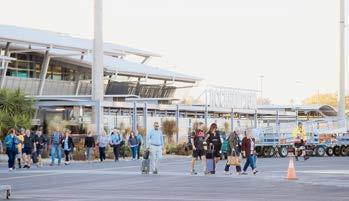
Develop a marina ferry terminal and facilities in the Fitzroy River to enhance the tourism and recreational potential of the riverfront
Water Security
Secure reliable and sustainable water sources for CQ to support the agricultural, industrial and residential needs of the region
Airport International Status
Upgrade and fund the Rockhampton Airport to international status to increase the connectivity and attractiveness of CQ as a destination for business and leisure travellers
Create an accommodation hub at the airport to provide convenient and comfortable lodging options for visitors, locals and business travellers
High Speed Connectivity and WiFi
Improve the high-speed connectivity and WiFi services in CQ to enable better communication, education and innovation opportunities for the region
Defence Force Major Maintenance Base
Establish a major maintenance base/hub for the defence force in CQ to leverage the existing facilities and proximity to the Shoalwater Bay Training Areas
Create a defence apprentice and traineeship program based in CQ, to provide skills development and employment opportunities for local youth
Establish a permanent Military Barracks in CQ to strengthen the defence presence and contribution to the region
Establish a Major Munitions Portal in CQ to support the defence industry and supply chain
in the region
Major Industrial Park and Logistics Hub
Create a major industrial park and logistics hub in CQ to attract and accommodate various industries and businesses that would benefit from the strategic location and resources of CQ
Advanced Medical
Enhance the advanced medical capabilities and services in CQ to improve the health outcomes and quality of life for residents and visitors
Tax Breaks North of Sunshine Coast
Offer tax breaks for businesses and individuals north of Sunshine Coast to incentivise investment and relocation to CQ
Potential Non-Government Projects
Establish space programs
Establish and attract a permanent movie/ cinema industry for Central and North Qld
Transition power stations into renewables/ nuclear/other
Establish a robotics and automation Centre of Excellence
Establish a ‘small home’ manufacturing industry
From this list, CQIC has chosen duplication of the Bruce Highway between Rockhampton and Gladstone as its highest priority.
While some may disagree, this choice has been informed by the imminent growth in Gladstone heavy industry, the increasing interconnectedness and complementarity between the two centres and the overarching need for upgrading the Bruce Highway everywhere north of Gympie.
CQIC will continue analysis of the lack of major projects and lobby where appropriate for this region to get its fair share to assist in building its capacity and capabilities for future generations.





Recently the economic and employment landscape of Central Queensland has undergone significant developments, reflecting broader shifts in industry and policy.
We have seen a focus on transitioning from traditional fossil fuel-based industries to renewable energy and clean industries, a move that promises to redefine the region’s economic future.
EMPLOYMENT GROWTH AND PROJECTIONS
Central Queensland is experiencing notable employment growth, driven by a combination of government initiatives and industry shifts.
According to Jobs Queensland, the region is projected to see an 11.5 per cent increase in employment by 2025-26, contributing to the broader state-wide addition of approximately 207,000 jobs.
The key sectors driving this growth include Health Care and Social Assistance, Professional Scientific and Technical Services, and Accommodation and Food Services.
RECENT EMPLOYMENT STATISTICS
The latest data from the Australian Bureau of Statistics (ABS) indicates a steady employment rate in Queensland.
As of June 2024, the trend employment in the state rose by 0.4 per cent, adding approximately 11,700 jobs.
This marks a positive trajectory for the region, aligning with the overall state growth and

The region’s economic future is increasingly tied to renewable energy and clean industries.
Central Queensland has abundant natural resources and an established industrial base, positioning it as a potential leader in renewable energy. Recent reports indicate that significant investments are being made in projects related to renewable hydrogen, green metals, and green chemical manufacturing.
This shift is supported by both local sentiment and government policies aimed at decarbonising the economy.
Residents in the region, particularly in the seat of Flynn, have shown strong support for prioritising investment in renewable industries over traditional coal and gas.
highlighting Central Queensland’s capacity to generate employment opportunities despite broader economic challenges.
Unemployment in Queensland remained relatively stable, with a slight increase in the unemployment rate to 3.8 per cent in July 2024, up from 3.7 per cent the previous month.
This marginal rise is not necessarily a cause for concern but reflects seasonal adjustments and ongoing fluctuations in the job market
As of June 2024 (the most recent data), Central Queensland’s labour force stands at approximately 127,316 individuals, with a notable employment rate across various industries.
Health care and social assistance lead employment sectors, followed by retail trade, education and training, and mining.
This diverse employment base highlights the region’s ability to provide a range of job opportunities despite economic fluctuations.


Henden’s Upholstery & Canvas is a locally owned, family run business that has been providing quality products for over 50 years. They specialise in the manufacturing of custom made: Henden’s specialise in understanding their client’s needs and providing custom solution driven designs. All products are manufactured on site at their workshop.
• Tradesman tool bags
• Document bags
• Safety permit wallets
• Machinery/Instrument covers
• Protective industrial covers
• Ship loader chutes
• Tarps, tonneau covers & shade sails
• Repair & maintenance work and much more
Find out how we can assist your team today.

Phone: 4972 3252
Email: admin@hendens.com.au
Website: hendensindustrialupholstery.com.au Find us on
The mining sector, a significant contributor to the regional economy, has seen steady employment levels thanks to sustained commodity prices and continued investments in mining projects.
Similarly, the agricultural sector has maintained robust employment figures, supported by favourable weather conditions and strong demand for local produce.
The construction sector also remains a vital part of Central Queensland’s economic fabric.
Recent reports highlight a series of infrastructure projects that have created numerous job opportunities.
From road upgrades to new residential developments, the construction boom is providing much-needed employment and stimulating local economies.
Recent polling by the Climate Council reveals that more than half of the population favours renewable energy investments, with this support being especially strong among younger residents.
The Queensland Government has been proactive in supporting this transition.
The state’s energy plan aims to attract clean industries and investors, with a commitment to power Queensland with renewable energy by 2030. This includes initiatives like the RenewableEnergyIndustrialPrecinctsprogram,which is expected to create thousands of jobs and secure billions in investments for the region.
Furthermore, the state’s employment strategy, “Good people. Good jobs: Queensland Workforce Strategy 2022-2032,” is investing heavily in training and skills development.
This initiative has already seen significant funding allocated to various grant programs, supporting over 44,600 workers and jobseekers in the last year alone.

















Despite these positive trends, Central Queensland faces several workforce challenges.
The region’s reliance on specific industries means that economic fluctuations in these sectors can significantly impact local employment.
Additionally, there is a growing need for skilled workers, particularly in technical and trade occupations.
Addressing this skills gap is crucial for sustaining long-term economic growth and ensuring that local industries can continue to thrive.
In response to these challenges, various initiatives are underway to bolster workforce skills and improve job readiness.
The Queensland Government, in collabo-
ration with local businesses and educational institutions, has launched several training programs aimed at upskilling workers and providing pathways to employment in high-demand sectors.
These initiatives are essential for equipping the workforce with the skills needed to meet current and future industry demands.
Looking ahead, Central Queensland’s economic outlook remains cautiously optimistic.
The region’s strong industrial base and ongoing investments in infrastructure projects are expected to support continued job growth.
However, external factors such as global economic conditions and commodity price volatility will play a significant role in shaping the region’s economic trajectory.
The region’s ability to adapt to these exter-
nal pressures will be critical.
Diversifying the economic base and fostering innovation across sectors can help mitigate risks and ensure sustainable growth.
Local businesses, government agencies, and community organisations must continue to collaborate to create a resilient and adaptable economic environment.
Central Queensland stands at the cusp of a significant economic transformation.
With substantial growth in employment projected and a strong shift towards renewable energy and clean industries, the region is poised for a dynamic future.
Continued support from government policies and investment in skills development will be essential to fully realise the potential of this transition.
As the CQ region navigates this transformative period, the balance between maintaining existing industries and embracing new opportunities will be critical to its economic resilience and growth.
In summary, while the region faces its share of challenges, the concerted efforts of various stakeholders to support job growth and economic development are bearing fruit.
Central Queensland stands as a testament to the strength and resilience of regional economies in Australia, poised to thrive in an everchanging economic climate.
Jobs in Central Queensland offer a holistic approach to your recruitment and talent attraction requirements.
For more information and insights about local job opportunities and recruitment support visit jobsincentralqueensland.au
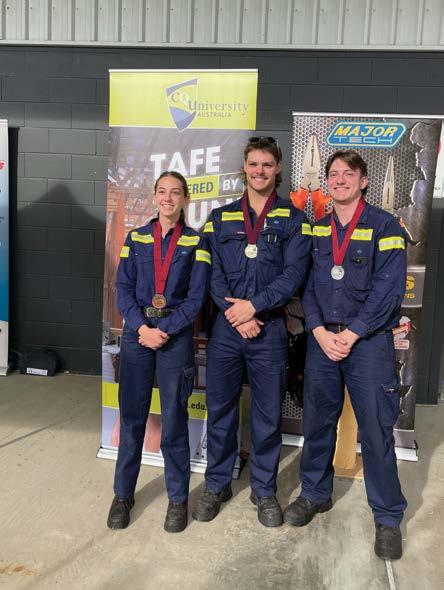



Eight years from now, Olympic athletes are being served IOC approved lab-grown meat in the Athletes Village, and the politicians are boasting how the Brisbane games will have netzero greenhouse gas emissions.
An unrealistic scenario!
“It would only be 5 to 10 years to widespread retail availability (of lab-grown meat) around the world,” Dr Uma Valeti, former cardiologist, now chief executive officer of UPSIDE Foods and in 2019, Foreign Policy magazines ‘Global Thinker of the Decade’ said.
If this prediction becomes reality, how does that affect Central Queensland and its two biggest industries, livestock, and coal?
“Throughout history, transformative industries have always triumphed over deep, entrenched opposition, reshaping societies for the better and this is no different,” Uma Valeti said.
This quote was at the end of a news story on lab-grown meat, now being sold by a Singapore Butcher.
Central Queensland with a lot smaller livestock industry, as well as coal industry? Would our reshaped society, be better?
Is this all just alarmist talk, that should be dismissed?
“The truth is that the livestock industry is not sustainable … we have to acknowledge this at one point, and so this science will go forward when (lab-grown meat) is globally accepted,” Associate Professor Alfredo Franco-Obregon from the National University of Singapore (NUS) Institute for Health Innovation and Technology said.
I feel to ignore the talk, and science, would be at our peril. The change indicators are obvious, an industry does not remain sustainable just because it is big. Example, the film processing industry, just ask the directors of Kodak, (remember it).
And what did the Covid years teach businesses about the need to pivot to survive?
Thus, the question that really needs to be answered is, what do we want Central Queensland to be like in 10 years’ time, 2034? Important to distinguish from the question of, what will CQ be like in 2034?
What do we want?
What do we want for the small communities like Dingo, Duaringa, Capella, Alpha, and

Jericho? Communities currently heavily dependent on the livestock and mining industries. (There are quite a few others in CQ, after all that is why most were established in the first place).
What do we want for our children in 10 years’ time, their job opportunities, where will they be, what industries will be employing, will they be able to afford a home?
If we do not add, ‘what do we want’, to the question about CQ 2034, I think we can guess what the outlook for small communities is likely to be, as a smaller livestock and coal mining industry sees existing job opportunities decline, the population with it, schools close, along with businesses.
Will these reshaped societies be better? If not, then what do we need to do now, to ensure they are?
I can remember the time I heard John Symond, say he can see the future, I thought what is he on about.
Make a prediction about the future based on current trends, sure, but here was the founder of Aussie Home Loans saying he could see the future. How, he explained, the future is not something we enter, it is something we create.
Can we take a page out of John Symond’s book, saying what future we want to create for CQ, cognisant that change is inevitable, then work towards it? Rather than being that frog in the pot on slow boil?
It seems to me we have a situation where, in larger communities, we have people who cannot afford a place to live, where in other parts of the state, we could have houses being abandoned.
Add the increase in employer acceptance of working from home, those wanting a quieter, more natural lifestyle, home schooling/shopping and improving connectivity, both digital and physical, then maybe there is a way we can make our small communities more vibrant.
Would, in 10 years’ time, your children living on a hobby farm outside Dingo, growing their own food, running some livestock, engaging the serviced of a farm butcher who originally came from Sydney, running their own online business from home, mixed with guided tours of Blackdown Tableland, sound rather idealistic.
Is it too idealistic!
What happens in the drought years, what jobs will their children be seeking and where?
There will always be what if’s, the big if though, if we do nothing, regarding the future planning for small communities like Dingo, what does happen to them and the impact this has on the whole of Central Queensland.
Many of these smaller towns only became towns, as new settlers, from all the world, bought smaller land holdings, which they could afford, and made a go of it. Some of their descendants still residing there.
We need to look at the technology that threatens the very existence of our small communities, and with it, the overall adverse impact it could have on the CQ economy, also as an opportunity, to reshape for the better. And prepare (plan) for it.
Challenge the theory that the big get bigger; the small will get wiped out. Small can be beautiful. Central Queensland has demonstrated time and time again, how resilient it is, and while both are significant industries, CQ is more than just cattle and coal.
‘The future is something we create.’
We know what future Uma Valeti, and many others doing similar cultivated meat processing, wants to create.
What future do we want to create for CQ?
CQUniversity’s newly appointed Dean of Engineering and Technology is on a mission to build industry-aligned programs, research capacity and industry engagement.
Professor Rabin Tuladhar started in the role last month and is already looking at ways to build and grow capacity within his School.
“I’m very keen to explore the current strengths that CQU already has and further enhance them,” Prof Tuladhar said.
“CQUniversity has been a pioneer and leader in online teaching and flexible delivery mode, and I want to further enhance our strength on flexible deliveries that ultimately improves student learning experiences, engagement and retention,” he explained.
“Further to that, I also want to explore opportunities to introduce innovative programs that are aligned with emerging industries. I’m keen to collaborate with the industries in our regions to foster transformative research that has a positive impact on the regional community and industries.”
Before joining CQU, Prof Tuladhar was Head of International Partnership in the College of Science and Engineering at James Cook University (JCU).
He also served as the Head of Engineering (2022-2023), and Associate Dean Learning and Teaching (2012-2018) for the College of Science and Engineering, also at JCU.
A civil engineer with specialisation in Concrete and Structure Engineering, Prof Tuladhar has the right mix of knowledge, skill and senior leadership experience to guide the School of Engineering and Technology to the next level.
“I’m originally from Nepal but have been travelling around quite a bit for my education and work,” Prof Tuladhar said.
“I did my undergrad in Civil Engineering from India, then I went to Thailand for my

Masters of Engineering. I completed my PhD in Earthquake Engineering in Japan,” he said.
Prof Tuladhar moved to Queensland in 2009, where he has established close collaborations with local industries to conduct translational research in the areas of sustainable and innovative construction materials, durability of structures, rehabilitation of aged infrastructure and structural health monitoring.
“I led the research team which was awarded

Banana Shire Council and the AUKUS Forumhostedathree-dayprogramlastmonth, designed to connect local manufacturers and service providers with defence contractors, advanced manufacturing specialists, including robotics, and research leaders.
This initiative highlighted the region’s potential and facilitated new market opportunities arising from the AUKUS agreement.
Site visits to Queensland Nitrates Pty Ltd (QNP), First Grade Contract Maintenance (FGCM), and Callide Manufacturing Company (CMC) showcased the local capabilities and skills, pinpointing new avenues for growth and collaboration.
These visits showcased the potential for innovative partnerships, for local manufacturing needs and pathways for local companies to adopt advanced manufacturing processes and tools, including robotics.
“This program underscores the incredible talent and capability within our region,” Banana Shire Mayor Nev Ferrier said.
“The partnerships formed and the opportunities identified through this collaboration with the AUKUS Forum are very important for the future growth of our local industries.”
In addition to the site visits, the Banana Shire Council hosted the latest “Introduction to Nuclear Course,” led by AUKUS Forum Advisory Board Member Jasmin Diab CSC GAICD.
This event saw participation from various local community leaders, including Mayor Nev Ferrier and Federal Member of Parliament Colin Boyce MP.
The Nuclear Task Force Advisory Board, composed of international experts from diverse sectors such as manufacturing, local government, defence, and nuclear law, played a crucial role in the course.
These experts provided invaluable insights and shared their extensive knowledge, contributing significantly to the success of the event.
the Australian Innovation Challenge 2015 for the development of 100 per cent recycled plastic fibre for concrete reinforcement,” he said.
In the coming months, Prof Tuladhar will visit CQUniversity’s various campus footprints to meet with staff, students, alumni and industry representative.
“I will be travelling to all the CQUniversity campuses in the first few months to meet staff and students face-to-face and understand their
aspirations and their challenges,” Prof Tuladhar said.
“I really want to inspire and support staff and students to recognise their strengths and help them to achieve their goals. That’s what really excites me in this role. CQUniversity’s mission to be Australia’s most accessible and supportive university resonates with my personal aspiration of creating student-centred, supportive learning environments.”

Queensland Alumina Ltd (QAL) is celebrating another milestone in the refinery’s long history after turning 57 years young on Sunday, 4 August.
QAL kickstarted the birthday celebrations by handing out cake to team members at entrance gates across site last week, encouraging them to test their knowledge of our refinery’s history with a birthday trivia quiz.
QAL Bayer production manager Glen Que reflected on QAL’s growth throughout the years after beginning his own career with our operations as an apprentice electrician.
“We’re extremely proud to reach another milestone in our refinery’s history while supporting our region through decades of community investment, while recruiting the largest workforce in the region,” Mr Que said.
“I started my own working career in Gladstone with QAL as an apprentice electrician, before carrying on into various roles in other companies and coming full circle back to QAL, where I moved into leadership positions.”
Construction on QAL began with the closure of the local meatworks in 1964.
The Parsons Point location was recognised as the ideal candidate for operations with credit to deep port access, a readily available workforce from the meatworks and, proximity to bauxite supply from Weipa.
QAL officially began production in 1967 as the world’s largest refinery, executing multiple expansions in the following years while leveraging the skills of a workforce closely knit with the neighbouring community.
“QAL does have a strong reputation in Gladstone, and I have many good memories, especially over the past few years,” Mr Que said.
“We’ve hit significant milestones and undertaken really challenging projects onsite, including the five-year environment strategy,

QAL celebrated its 57th birthday earlier this month. (File)
which I was involved with through the installation of a new alumina ship-loader. “This is a really important part of QAL’s history and we’re just as invested in our local community as ever before, continuing to support events and com-
munity organisations through our community investment fund.
“QAL has a really clear pathway to how we decarbonise and reduce our emissions as a

Major works have begun to transform the Stanwell Power Station into a Clean Energy Hub with bulk earthworks now underway on the $747 million Stanwell mega battery project.
Publicly owned energy company Stanwell is partnering with Tesla and Yurika to build the giant 300MW/1200MWh system capable of supplying energy into the grid for up to four hours.
The mega battery project will include 324 lithium-ion Tesla Megapack 2XL units which will be transported on trucks to site and craned into place.
The project was recently supercharged with a $448.2 million funding boost from the State Government’s Queensland Renewable Energy and Hydrogen Job Fund with the Premier and Energy Minister announcing in May it’s capacity would be doubled.
Work has also reached the halfway mark on Stanwell’s first dispatchable energy (storage) project, the $514 million Tarong mega battery
project, part of what will be the Tarong Clean Energy Hub.
Construction on the 300MW / 600MWh project with two hours storage commenced in August 2023 and is due to be fully operational mid-2025. The heavy lifting on all 164 Tesla Megapack 2XL battery units have been completed with work now underway to connect them to the transformers.
Around 160 construction jobs have been created for both projects.
Energy and Clean Economy Jobs Minister Mick de Brenni said this battery project is the largest of its kind in Queensland and will create around 80 jobs in construction.
“What batteries deliver to the Queensland SuperGrid is reliable power,” he said.
“When batteries like this are publicly owned it means Queenslanders themselves benefit, not overseas shareholders.
“We want to ensure we maintain downward
pressure on power bills for all Queenslanders by building more renewable energy and storage.”
Stanwell CEO Michael O’Rourke said dispatchable energy assets like the Stanwell and Tarong big battery projects are critical as we transform our energy system.
“The big batteries will play a crucial role in the energy transformation by stabilising energy supply from clean renewable sources, meaning they’ll be able to be charged by sources like wind and solar and pumped back into the grid during periods of high demand,” he said.
“This will ensure affordable and reliable electricity for our commercial and industrial customers in Queensland and the Eastern Seaboard.
“They are a key piece of our commitment to achieving 5GW of energy storage by 2035 and highlights Stanwell’s vision for a sustainable and innovative energy future.”
refinery, so that will be the next piece of work over the next decade as we work through those projects and ensure QAL can continue to operate and support generations of the community to come.”
By Poppy Johnston, AAP
Wages rose by 4.1 per cent over the year to June, the same result as in March and a little above expectations.
The latest Australian Bureau of Statistics figures show wages lifting 0.8 in the three months to June, from a 0.9 per cent rise in March.
Consensus forecasts had pencilled in a 0.9 per cent increase over the quarter.
The annual growth in wages was 0.3 percentage points higher than the annual inflation rate of 3.8 per cent in June, representing another improvement in worker pay in real terms.
Wages have been running ahead of inflation since late 2023.
Private sector wages grew 0.7 per cent in the June quarter, down from 0.9 per cent in the three months to March.
ABS head of prices statistics Michelle Marquardt said this was the equal lowest rise for any quarter since December quarter 2021.
Public sector wages increased 0.9 per cent, up from 0.6 per cent in the March quarter, with all Australian public service employees receiving pay increases in March,
Usually, these salary bumps are more sporadic to reflect the timing of individual agency agreements.
“The stronger June quarterly rise for the public sector was largely due to the newly synchronised timing pattern of Commonwealth public sector agreement increases,” Ms Marquardt said.
The bureau’s wage price index lands at a critical point in the central bank’s price fight.
The Reserve Bank of Australia kept interest rates on hold at its August board meeting but struck a hawkish tone, warning inflation was still high and pushing back on expectations of near-term cuts.
By McKenzie Neal
The GroWQ Innovation Expo successfully brought together the agricultural community in Outback Queensland for two days of insightful discussions and cutting-edge demonstrations.
The event, held on 25-26 July at the Longreach Showgrounds’ Wool Pavilion, served as a crucial platform for sharing knowledge and exploring the latest advancements in the industry.
With 29 speakers, including seven producers, the expo covered a wide range of topics such as property security, trough filtration, mustering with drones, virtual fencing, and the application of artificial intelligence in agriculture.
The event also featured two engaging discussion panels and 30 trade displays, offering attendees a comprehensive look at the latest innovations.
SQNNSW Innovation Hub’s Prue Button was thrilled with how the expo went and said that early feedback from attendees has been positive.
“We were thrilled with how it all went,” Ms Button said.
“We had a really good roll up of people and we had great speakers which was really good to see.
“A lot of people said how much they enjoyed it and how they got a lot out of it.
“There were innovative things that they can now apply to their practices which is great to see.”
A highlight of the event was the presenta-
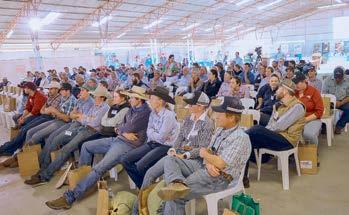
tion by Jack Carmody, who is a man who has done a lot of work in remote settings around Australia.
“Jack Carmody was great and definitely a highlight,” Ms Button said.
“There were a lot of people who said they really enjoyed him and a few of the stories he spoke about.
“He is a pretty interesting guy who has done a lot of stuff in really remote settings around adaption of technology and creating systems.”
There was a networking dinner at the Branch which followed proceedings on Thursday, with Ms Button saying that it was a success.
“This year we had 192 people who came to the expo, and then 96 of them came to the Branch which was good,” she said.
“It was a great night with lots of chatter – following up networking and different things.
“Even a few of the trade displays actually went out to some people’s properties afterwards for more follow-up visits.”
Investigation, creation and innovation were all on display at two recent specialist workshops held at Redeemer Lutheran College in Biloela.
Students from Years 7, 8 and 9 discovered more about the practical application of physics in a Heavy Hydraulics workshop, while the Year 10 students became Tradies for a Day, completing a series of practical trade activities.
Both workshops were delivered by the Queensland Minerals and Energy Academy (QMEA), the education arm of the Queensland Resources Council (QRC), with the generous support of Batchfire Resources.
While the workshops each had a different focus, they shared a common goal of applying concepts learnt at school to activities in mining operations.
Batchfire Resources chief executive officer Alan Fidock said the company is proud to support yet another QMEA workshop after a successful STEM Unearthed workshop last term.
“Education is the backbone of a rewarding career in resources, and at Batchfire we are keen to help local schools deliver workshops that stimulate the students’ interest in STEM and vocational studies,” Mr Fidock said.
“We hope many of these students remember this day and apply for future apprenticeship or graduate programs at Callide Mine.”
QRC Skills, Education and Diversity director Katrina-Lee Jones said the aim was to stimulate the students’ interest and open their minds to the potential careers they could have in the resources sector.
“In the Heavy Hydraulics workshop the students were challenged to design an extension to a model hydraulic arm, with the criteria that it needs to be able to either lift, move or dig an object – similar to an excavator,” she said.
“They worked in groups to create the design and implement it on their hydraulic arms, giving them an idea of the physics behind mining machines and the various attachments required to perform different actions on site.”
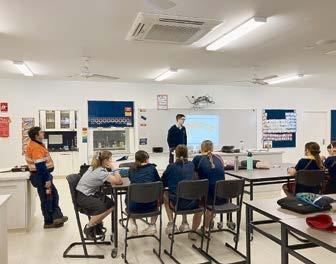

She said the Year
been
“They rotated through a series of different trades-based activities under the guidance of our VET project officer and experienced

tradespeople from Batchfire, who also were able to share their career experiences,” she said.
For more information on starting a career in the resources industry visit; shapeyourfuture.com.au
Understanding the basics of emissions is becoming increasingly important for Australia’s farmers as the sector faces growing expectations to measure and reduce greenhouse gas emissions on farm, according to agribusiness banking specialist Rabobank.
In a new guide produced for its farming clients, Cultivating clarity in Australian agriculture: Making sense of supply chain emissions targets on-farm, by the bank’s RaboResearch arm, Rabobank says as large corporations – including food and agribusiness companies – become more active in managing climate impact across their full supply chain, this is expected to have increasing market access implications for farmers.
“As these expectations start to flow back towards farm level, understanding the basic concepts around emissions measurement – including the different scopes of emissions, what a farm’s greenhouse gas footprint is made up of and the significance of key emissions metrics – is becoming important in preparing farmers for these fast-approaching changes,” says report author, RaboResearch sustainability analyst Anna Drake.
Ms Drake said many farmers reported feeling confusion and uncertainty when it came to the topic of GHG emissions.
“This includes how to measure and reduce emissions and why this is likely to be relevant to their business,” she said.
Ms Drake said the guide was designed to provide the bank’s clients with a foundational overview on the topic of emissions as it relates to agricultural supply chains and the expected impacts on farmers.
“With growing focus on emissions in agriculture and the widespread introduction of company emissions reduction targets that include on-farm emissions, it is important farmers are well informed so they can best position themselves to respond to changes ahead, including potential future market access impacts,” she said.
In particular, Ms Drake said, the report was designed as a farmer’s guide to navigating corporate emissions reporting and supply chain commitments. It examines emissions in agriculture from three perspectives: market and supply chain, farm and global.

By Matthew Pearce
‘Strategy Guy’ John Hale will be the opening and closing keynote presenter at the Capricornia Chamber of Commerce’s Harvey Norman Unleash the Business Power Seminar and Expo on Thursday, 29 August.
Regional business advocate and past Capricornia Chamber president Phil Henry said Mr Hale’s insights were sure to inspire local business people.
“John’s presentations are entertaining and engaging, but most importantly, they inspire new and practical ways of thinking - strategic thinking,” he said.
Mr Hale is the founder of Hale Consulting Group and will join other special guest speakers, including Damian Morgan (sales mastery) and Catherine Molloy (customer marketing), at the event at the Yeppoon Town Hall.
Also featured will be 20 exhibitors representing fields from bookkeeping to recruitment and AI.
Mr Hale brings over 30 years of experience leading projects, facilitating workshops and coaching leaders.
His clients include notable brands such as Westpac, Aldi, Toyota, Dulux, Origin, KPMG, HP and CAANZ, as well as local, state and federal government agencies.
As a visiting professor, he has taught in five business schools including Singapore University, Bond University and Melbourne Business School and is the author of four popular books on strategy and leadership.
The father of four describes his presentations as both relatable and practical.
“I will start the conference by helping attendees cultivate a strategic mindset to futureproof their businesses, focusing on three critical questions from The Strategy Book: ‘What’s really going on here?’, ‘What are our options?’
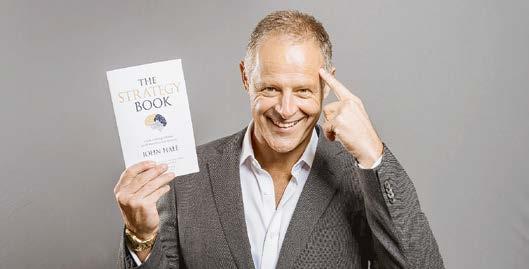
and ‘What will we do?’,” he said.
To encourage deeper engagement beyond the event, he will give away copies of The Strategy Book to lucky audience members.
All four of his books and discounted coaching offers will be available for attendees at special event prices.
In the closing session of the conference, Mr Hale will share leadership lessons designed to bridge the gap between strategy formulation and its implementation within an organisation, emphasising the importance of caring for
people, knowing which way to go and aligning resources effectively.
“Additionally, I will discuss how understanding different employee motivations through Theory X and Theory Y can help leaders adopt appropriate leadership styles and maximise team performance.”
He will also provide valuable tips for recruiting and retaining top talent, along with actionable strategies that attendees can implement in their businesses.
“My practical approach and extensive expe-



rience offers those attending not only proven knowledge but also real-world examples that can drive significant improvements in an attendee’s business,” he said.
“My two sessions will inspire, educate and equip business owners and leaders with the tools needed to navigate today’s business environment with confidence and greater insight.”
To register for the expo, go to events@capricorniachamber.com.au

